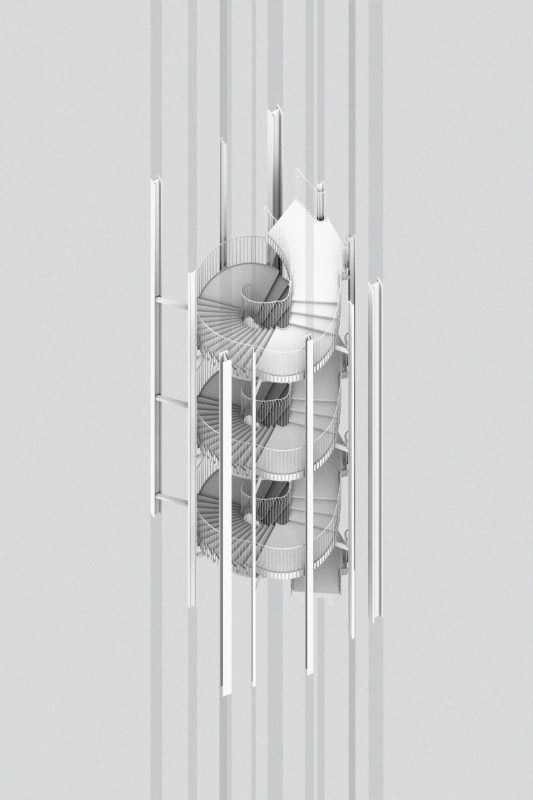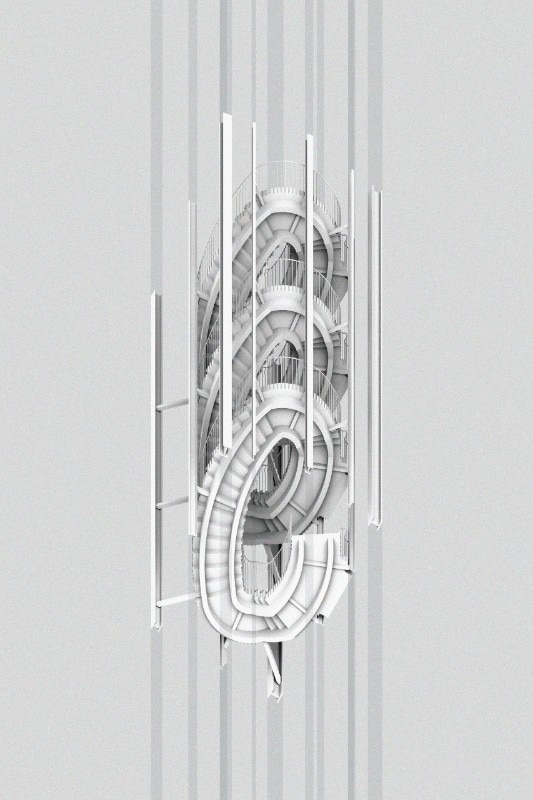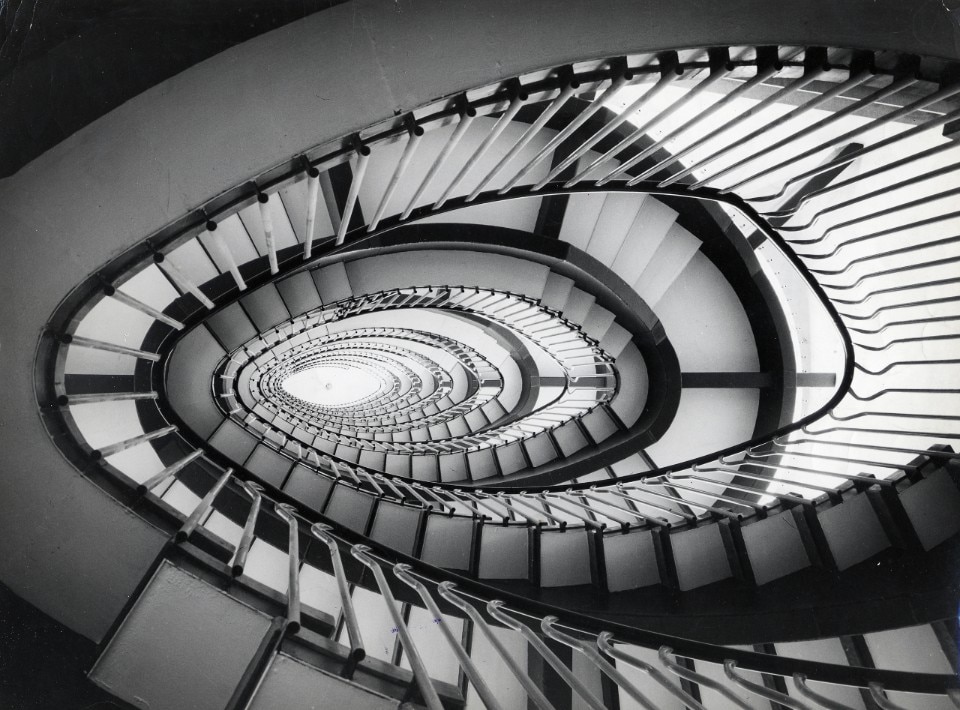This article was originally published on Domus 1058, June issue.
Franz Kafka’s enigmatic aphorism, “I am a cage, in search of a bird,” while a metaphor for the trappings of modern life, evokes a raw physicality. It is an image lodged in the real, material world. Kafka offers a tense dialectic between contained and container by subverting the typical bird/cage relationship. Here, the cage precedes the bird, but the implication is that the bird to be found is specific to the cage. This push-and-pull perfectly describes a spiral stair designed by Franco Albini and Franca Helg for their Rinascente department store in Piazza Fiume, Rome, in 1961. The circulation spine, a masterwork of compound geometry and construction, paradoxically binds fluid form to the strict armature that holds it up. Albini and Helg’s design for the Rinascente building coalesces the tempered tastes of the Milanese industrial bourgeoisie (both the office of Albini and Helg and the headquarters of Rinascente were based in Milan) with the web of municipal mandates and atmospheres, literal and figurative, unique to Rome. Its facade, for example, an opaque, corrugated screen on a steel substrate, encompasses structure and mechanical systems while evoking fragments of the historical context in its cornice-like form and in its colour, matched to the brick of the nearby Aurelian Walls.
Albini and Helg here fine-tuned their rationalist tendencies of abstraction to a decidedly Roman public. While much attention has been paid to the way the facade mediates the challenges of site and construction and is, therefore, the most visually immediate evidence of site specificity, the geometric resolution of the stair offers a subtler manifestation of the same concerns. The stair at the Rinascente relates to a series of earlier spirals designed by Albini, many of which exhibit a dialogue between the core and its peripheral support. Kay Bea Jones has characterised Albini’s typical circular stair as an “elegant artifact revealing its very choreography”, fittingly contrasting it with the “closed chamber” stair of his American contemporary Louis Kahn (Suspending Modernity: The Architecture of Franco Albini, Routledge, New York 2014). One of the most notable of Albini’s oeuvre is the exquisite example at the Galleria di Palazzo Rosso in Genoa. Designed just prior to the Rinascente, the armature here, while present, is suppressed relative to the stair within. This is an exercise in unreal lightness. The structure’s thinness relates to its tensile role, appearing like a wireframe drawing hanging from above. While its relationship to the stair is intrinsic, it is visually secondary, rendered transparent to reveal the main event of vertical movement.


At the Rinascente, however, one must account for a more complicated version of this relationship. Instead of one dominating the other, the spiral and its surround are in an oscillating dance, each equally realising the other. The plan of the overall building negotiates the irregularities of the site (or the pre-existing context, to use rationalist terminology) with the volumetric purity of the rectangular prism that sits upon it. The result of this tension is a spatial remainder: a void at the corner of the project that houses the main public stair. The void’s oddly shaped perimeter is defined by the site negotiation, which, in turn, informs the plan configuration of the stair. A distorted helix, it is squeezed by the forces that are out of immediate sight. Between that invisible, regulatory framework of the city and the stair in the void is what we can call a cage: a lattice-like arrangement of steel columns and beams, sometimes concealed, sometimes plainly visible. This ambiguous presence of the lattice denies a magical conception of a structureless stair. In other words, the stair is in suspension, but it is not floating.
This ambiguous presence of the lattice denies a magical conception of a structureless stair. In other words, the stair is in suspension, but it is not floating.
Suspension is not just the product of the structure’s visible presence, but also of its periodic disruption of the stair’s continuous geometry. In the plan view, a tightly calibrated relationship of arcs that shape the staircase is evident. If, theoretically, the ideal form of the spiral in plan is a circle, the distorted version in this case is a symmetrical but rotated lozenge, comprised of larger arcs along the sides that tangentially meet smaller arcs at the ends. Because the radii of the larger arcs are coincident with those of the smaller arcs, a smooth transition is ensured between the two sets, producing a continuous, if slightly awkward, loop. With this concerted effort to achieve continuity in plan, one would imagine a similarly consistent motivation to drive design decisions in elevation, but that is in fact not the case. When Albini and Helg’s spiral is seen from the top, looking vertically down the central void in perspective, the resemblance to and even influence of Giuseppe Momo’s Bramante Staircase at the Vatican Museums is undeniable. But when seen laterally and from below, a syncopated rhythm takes over from the effortless flow of the whirl. From these vantages, one observes the beams that protrude horizontally from the perimeter columns and carry the stair at its landings.
These are connected to a pair of box-beam stringers than run along the underside of the treads, following its profile from flat at the landings to a short slope for a three-step segment and then to a long slope for the main stair segment. With all the virtuosity exhibited in the complex curvature of the bent stringers, no such effort seems to be spent on easing the transitions between segments geometrically. The handrail, while subtly filleted between segments, only amplifies this appearance of discontinuity. The result is a visual on-and-off effect as the eye traces the jagged contours of the spiral. The drawings accompanying this article reveal these interrelated qualities through the convention of plan-oblique projection. In these views, the stair appears to be a writhing figure within the confines of the contorted frame. But take away one of the protagonists from the drawing – the stair or the structure – and the construction ceases to make sense. Inasmuch as the overall composition seems unwieldy, it is congruent. Stair and structure, bird and cage, are held in a state of equilibrium.
Ajay Manthripragada An american architect born in 1980 in Vizag, India, he founded his design practice in California in 2014. He is an assistant professor of architecture at California Polytechnic State University, San Luis Obispo, and has also taught at UC Berkeley and Rice University. In 2018 he was nominated for the Mies Crown Hall Americas Prize as an emerging practitioner.
Opening image the spiral stair viewed from above. Photo Courtesy Fondazione Franco Albini


